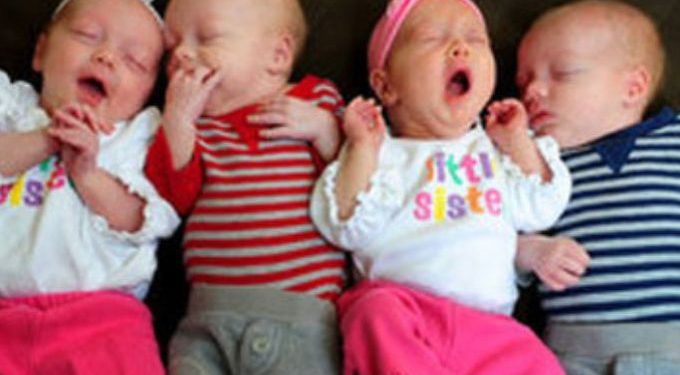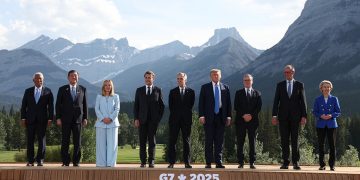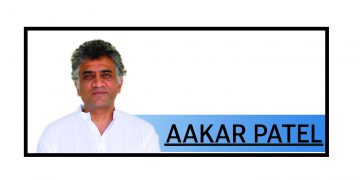COLUMBUS, Ohio: Annie Johnston sat close to her sister, Chrissy Knott, and held her hand under the blue surgical draping as the medical team worked toward closing the incision low on Chrissy’s abdomen.
Annie’s gaze shifted between the teary eyes of the woman she has loved forever and the hollering babies she longed to hold.
‘You can go look at your babies, Annie,’ Chrissy said.
‘But I don’t want to leave you,’ Annie replied.
‘It’s OK. Go,’ Chrissy said. A tear slid down her cheek.
Annie had just become a mother of two boys that her sister had carried for her. Her own belly swelled with the promise of the boys’ sisters.
After years of wanting children and of disappointing efforts to make that happen, Annie and her husband, Joby, both 34, were welcoming quadruplets nobody expected in a manner that has astounded and delighted everyone from doctors to strangers in hospital hallways.
But on Oct. 24, in an OhioHealth Riverside Methodist Hospital operating room, no amount of awe over the rarity of these births could compete with the joy.
Annie and Joby fell in love at Ohio University, where she had followed Chrissy. They married in 2005. Three years later, they decided to start a family.
‘When we were ready, we thought it would just happen,’ Annie said.
What followed were five years of dashed hopes and no answers. There were drugs to boost fertility, artificial inseminations and a search for what might have impeded fertility in both would-be parents. Annie underwent exploratory surgery that found nothing.
Eventually, they tried in vitro fertilization. None of the four embryos that were implanted in pairs months apart resulted in a pregnancy. ‘You just feel helpless,’ Annie said.
Joby had surgery to remove a varicose vein, on the outside chance it was contributing. There were more tests and fertility shots and another try with artificial insemination.
And then there was Chrissy.
Chrissy is 37 and mom to Oliver, who is 2, and Wendel, who is 5. She’s married to James Knott, who also went to OU. They live seven houses from Annie and Joby in Lewis Center in southern Delaware County.
Chrissy was hurt for Annie. She thought she might be considered too old to be a surrogate, but she wanted to help if she could.
‘We’ve always been so close, and I knew how badly she wanted to help,’ Annie said.
Chrissy’s husband said the decision was likely harder for Annie and Joby than for him and his wife. Helping them was natural, James said, but it also meant for Annie that she would not carry her own child.
‘We made beautiful embryos,’ Joby said.
‘We just needed someone else to carry them,’ his wife said.
With no answers as to what might have stood in the way of Annie’s becoming pregnant, her fertility specialist hadn’t given up on the possibility, Annie said.
Doctors see it sometimes. A couple stops trying to get pregnant, and that’s when it happens. There’s much that scientists have come to understand about infertility, but much remains a mystery.
In what at that point felt like a medical Hail Mary to the family, Dr. Steven Williams of Ohio Reproductive Medicine implanted two embryos in Annie’s uterus in addition to the two in her sister’s.
‘We wanted to increase our odds of getting at least one,’ Joby said.
The chance of in vitro leading to a successful delivery for a woman Annie’s age is about 46 percent, based on national data from 2011, the most recent available. For a woman Chrissy’s age, it is about 38 percent.
The chance of twins: about 14 percent and 10 percent, respectively, according to the Centers for Disease Control and Prevention’s most-recent report.
Williams had made clear that there was a chance that they’d have twins and the added risks that come with that. It seemed so improbable to Annie and Joby after all they’d been through.
And yet, ‘We were ready for a new problem. If the worst problem he can give us was now there would be four babies, we were ready,’ Joby said.
That night, the sisters, who’d been told to rest for a day, shared Annie’s bed and talked and hoped. Joby remembers admiring the selflessness of his in-laws.
Accustomed to being let down, Annie and Joby were ready for bad news.
‘We didn’t want Chrissy to feel bad, especially, if it didn’t work,’ Annie said.
Chrissy was excited, worried and steeling herself for how they’d get through as a family if the news wasn’t good.
The news came in a voice mail. They listened together.
‘I’ve got double-great news…’
They gasped and laughed and gasped some more.
‘Really? So it’s official,’ Annie said.
Now they both knew they were pregnant. They figured that meant each sister would deliver one baby. Ultrasounds in March showed otherwise. Quadruplets were on the way.
Later, they learned that Chrissy was carrying two boys; Annie, two girls.
As girls and young women, they’d imagined being pregnant at the same time, but neither expected this.
‘Emotionally, mentally, in my heart I’m doing this for them,’ Chrissy said about seven months into the pregnancies.
She wasn’t worried about heartache when she slept at home with the boys tucked away down the street.
‘I think of them as my nephews, and I know I’ll be very involved in their lives. It would be harder if they lived far away.’
One fetus, by then called ‘Baby Boy A,’ was breech. He didn’t move in the next several weeks, meaning Chrissy would need a Caesarian section.
The scheduled date, Oct. 24, was 38 weeks into the pregnancy, an optimal time to deliver twins, said the sisters’ obstetrician, Dr. Jaina Lindauer of Northwest OB-GYN.
Annie had decided that if the girls didn’t come on their own first, she’d follow her sister into the operating room. The other option was inducing labor, but that didn’t guarantee a successful vaginal delivery for Annie and meant the girls might not arrive on the same day as their brothers.
Both couples arrived at Riverside before sunrise on Oct. 24.
Chrissy went first, as planned, so that Annie could be there for her sons’ delivery. As Lindauer made the incision, the sisters looked in each others’ tear-filled eyes. Joby massaged Annie’s back and leaned his head into hers.
‘Is there like a countdown?’ Chrissy asked.
Within seconds, they were greeting Charles Kortlandt, born at 8:03.
‘He sounds like a chicken! He’s so little,’ Chrissy said as Lindauer held the boy aloft for his parents and aunt and uncle to see. ‘Welcome to your new world.’
At 8:05, Thomas Sellman followed.
After she left her sister’s side, Annie spoke quietly to her boys. ‘Hey, baby, hey. How are you doing?’
Joby placed one hand at Charlie’s head, another at his feet and beamed.
‘Do they look different, Annie?’ Chrissy asked.
‘They look like babies,’ her sister answered, smiling.
As Chrissy recovered and Annie prepared for the girls’ arrival, she asked how it felt to wait while Lindauer and her team finished the operation before she could hold her daughters.
‘Did it seem like forever?’
‘Yes,’ Chrissy answered. ‘I would say, ‘Just take some deep breaths.’??’
At 9:48 and 9:51 a.m., Annie and Joby welcomed Grace LaVelle and Hadley Somei. Tears rolled down Annie’s face as Lindauer held them up.
‘How do they look?’ she asked Joby after they’d been placed in warmers.
‘Great. Perfect,’ he answered.
Charlie, Tommy, Grace and Haddie are now home with their busy yet delighted parents. Annie and Chrissy’s mom and dad – Satoko and Karl Kortlandt, formerly of Tiffin in northwestern Ohio – have moved in to help.
There are closets full of diapers and stacks of clothes and charts to remind them of who was fed when.
There are four of everything, sometimes more.
There are grown-ups caring for babies in shifts and trying to figure out how all the equipment works and discussing who looks like whom.
There has been at least one joke about slapping stickers on the babies’ foreheads to keep things straight for those who can’t easily tell them apart.
And there are an aunt and uncle down the street who are always happy to help.
Credits:- Morningjournal






































